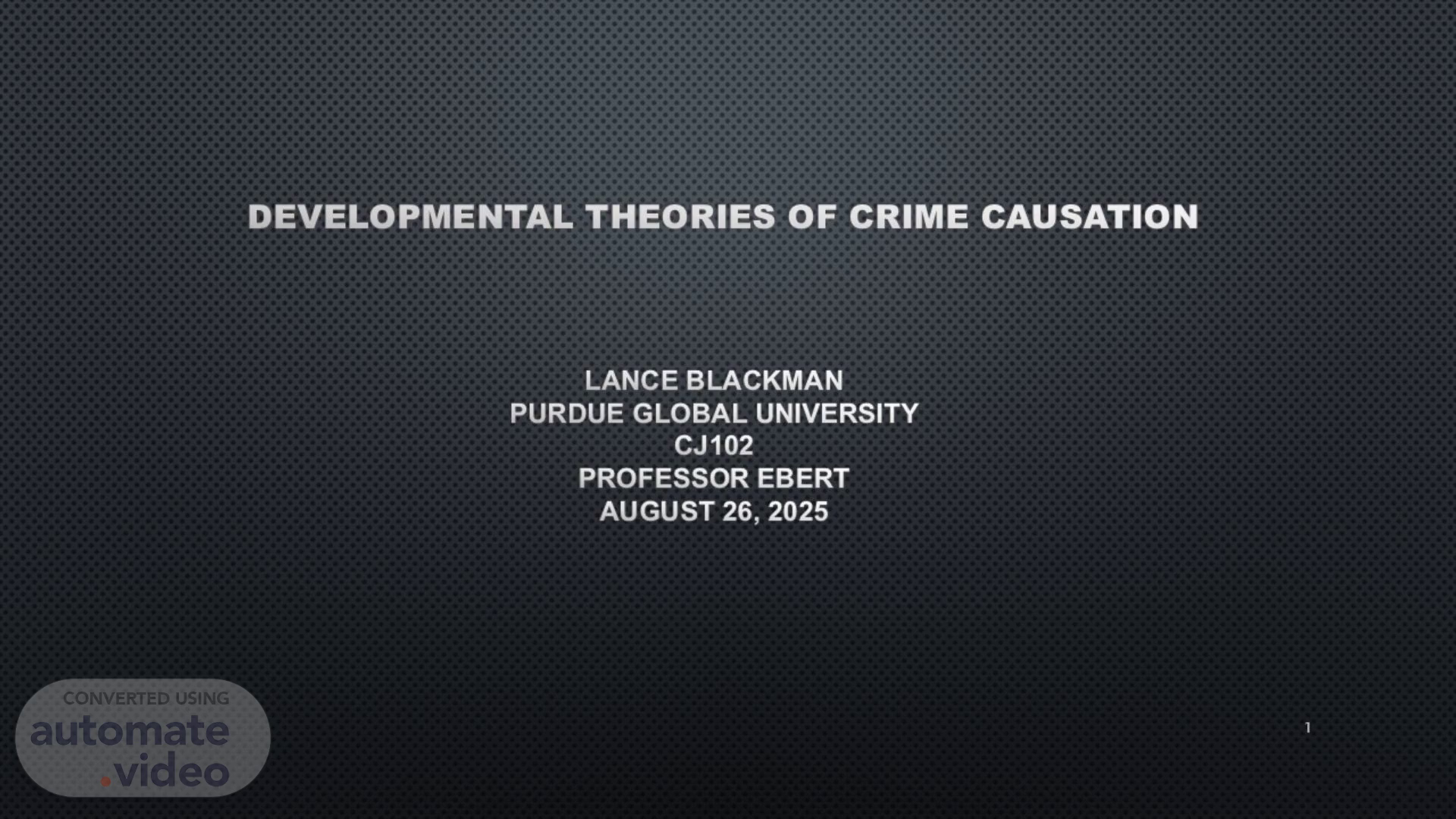
Developmental Theories of Crime Causation Lance Blackman Purdue Global University CJ102 Professor Ebert August 26, 2025
Scene 1 (0s)
[Audio] Welcome to my presentation on developmental theories of crime causation. Today we will explore three major theories that help explain criminal behavior, examine Cohen's Theory of Delinquent Subcultures, and analyze Anderson's Code of the Streets with current real-world applications. These theoretical frameworks provide essential perspectives for understanding how criminal behavior develops and persists in society, offering valuable insights for criminal justice professionals and policymakers..
Scene 2 (32s)
[Audio] Understanding crime causation requires examining multiple theoretical perspectives that each contribute unique insights into why individuals engage in criminal behavior. Biological theories examine genetic and physiological factors, psychological theories focus on mental processes and personality development, while sociological theories investigate how social environments and cultural factors influence behavior. Modern criminology recognizes that these perspectives often interact, meaning criminal behavior typically results from complex combinations of individual and environmental factors. Today's presentation will focus primarily on sociological approaches, specifically examining how social conditions create subcultures that may promote criminal activity..
Scene 3 (1m 24s)
[Audio] Biological theories have evolved from simple genetic determinism to sophisticated biosocial approaches that recognize how biological predispositions interact with environmental factors. These theories examine how brain dysfunction, hormonal imbalances, diet, and neurological makeup combine with family and neighborhood conditions to influence behavior. Psychological trait theories focus on mental processes, encompassing psychoanalytic perspectives that emphasize early childhood experiences, behaviorism that studies social learning and modeling, and cognitive theories that analyze how perception affects behavior. Both approaches have moved away from deterministic views toward understanding crime as resulting from complex interactions between individual traits and social environments..
Scene 4 (2m 16s)
[Audio] Sociological theories examine how social structures, economic conditions, and cultural factors create environments that either promote or discourage criminal behavior. These theories argue that crime is not simply an individual choice but a product of social forces including poverty, inequality, social disorganization, and cultural conflicts. Subcultural theories, which we'll examine in detail, suggest that criminal behavior often represents a rational adaptation to social conditions that block access to conventional success. Understanding these social dynamics is crucial for developing effective crime prevention strategies that address root causes rather than just individual behaviors..
Scene 5 (3m 3s)
[Audio] Albert Cohen's 1955 theory explains juvenile delinquency through social class conflict and status deprivation. Working-class boys face "status frustration" when unable to meet middle-class standards emphasized in schools and other institutions. These standards include academic achievement, delayed gratification, and conformity to authority. When consistently failing to meet these expectations, boys experience rejection and inadequacy. Rather than accepting failure, they engage in "reaction formation," completely rejecting middle-class values and forming oppositional subcultures with inverted norms. This explains why much juvenile delinquency appears "non-utilitarian" - it serves to gain status within the delinquent subculture rather than material benefits..
Scene 6 (3m 57s)
[Audio] Elijah Anderson's 1999 ethnographic study in Philadelphia's inner-city neighborhoods revealed an informal code governing street behavior. He distinguished between "decent" families who maintain mainstream values despite economic hardship, and "street" families who embrace street culture for survival. The code centers on "respect" - a person's reputation that must be continuously defended. This involves physical and mental toughness, with immediate retaliation required for any sign of disrespect to avoid appearing weak and inviting further victimization. While not everyone fully embraces the code, most residents must navigate its expectations for safety in environments where formal institutions like police are less effective..
Scene 7 (4m 43s)
[Audio] Anderson's Code of the Streets theory remains highly relevant in understanding contemporary urban violence, particularly how social media has transformed street conflict dynamics. Online "disrespect" through social media posts, videos, and comments now serves as a primary catalyst for gang-related violence. The principle that public disrespect demands immediate retaliation has intensified in the digital age, where humiliation can go viral instantly. This creates "digital-to-physical violence cycles" where online provocations escalate into real-world confrontations. Traditional criminal justice approaches often fail because incarceration can enhance street credibility rather than serve as a deterrent, leading some police departments to adopt community intervention programs that address the underlying respect dynamics..
Scene 8 (5m 37s)
References Anderson, E. (1999). Code of the street: Decency, violence, and the moral life of the inner city. W. W. Norton & Company. Cohen, A. K. (1955). Delinquent boys: The culture of the gang. Free Press. Hyatt, J. M., Densley, J. A., & Roman, C. G. (2021). Social media and the variable impact of violence reduction interventions: Re-examining focused deterrence in Philadelphia. Social Sciences, 10(5), 147. https://doi.org/10.3390/socsci10050147 Nickerson, C. (2024, February 13). Subcultural theories of deviance. Simply Psychology. https://www.simplypsychology.org/subcultural-theories-crime-deviance.html Siegel, L. (2022). Criminology (8th ed.). Cengage Learning US. https://purdueuniversityglobal.vitalsource.com/books/9798214341149.